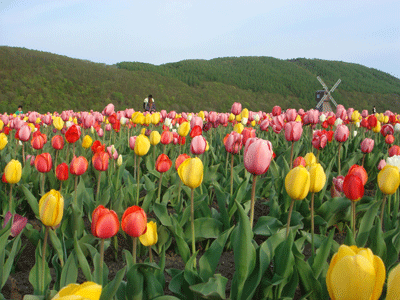This spring bloomer comes in just about every color in a color wheel ranging from bold and bright — orange, red, and yellow– to cooler colors– like pink, purple, and lavender.
Tulips don’t need to be replanted each fall, though they’ll only flower well for about three years before needing to be replanted, according to Jay Hutchins, General Manager at Brent and Becky’s Bulbs. To keep your garden looking tidy, remove the yellowish-brown leaves of the tulips after they’ve finished flowering by grabbing hold towards the bottom of the leaf and giving it a little twist while pulling upward.

When to plant:
Plant tulip bulbs in fall after the ground has cooled, which means late September to early October in the northern states (zones 3-5), and into November in the southern states (zones 6-8). Click the calendar (right) to find your climate zone using your zip code. In some southern states, particularly Florida, southern Louisiana, and the desert Southwest, the ground doesn’t provide a sufficient cooling period to initiate spring blooming. If you garden in these areas you can purchase prechilled tulip bulbs starting in January from bulb growers like Brent and Becky’s Bulbs.
Where to plant:
Plant tulips in full sun and in well drained, preferably sandy loam soil. Plant them in a cluster in flower gardens and boarders, in front of a picket fence, and near the entryway to a home. If necessary, amend the soil (especially clay soils) with well composted livestock manure and organic material.
How deep to plant tulips: All bulbs follow the same rule-of-thumb for determining their planting depth; plant the bulb 2-3 times as deep as the bulb is tall. Most tulips will need to be planted 4″ – 6″ deep but there are instances where the larger bulbs will need to be planted 8″ deep. We’ll show you an easy way to plant your bulbs in a few moments.
Spacing:
Follow package directions regarding spacing for your tulips but generally you’ll want to space them about 4-6 inches apart.
How to plant tulip bulbs:
Let’s face it, most bulb planting methods have us spending a lot of time bending over or on our knees. The ProPlugger 5-IN-1 Planting Tool allows you to do most of the hard work of digging your bulb planting holes from a standing position.
To pull plugs, slide the 2″ or 4″ metal depth ring onto the bottom of the main tube to set the desired depth of the planting hole. Or to dig a 6″ deep hole, no depth ring is needed.
(Step, Twist and Pour) Step down on the foot pegs until the depth ring bottoms out against the ground. Give the 5-IN-1 a slight twist to break the soil plug free and pull straight up on the handle bars. To empty the soil, simply turn the plugger upside down and pour the soil out of the top of the tube.
The soil gets stored inside the tool as you work, enabling you to dig over a dozen planting holes, one right after another. Place the bulb in the planting hole, pointed tip facing upward. Fill in the hole with the soil you removed with the 5-IN-1. Firm the soil over the bulb with your foot.
Note: You can dig holes for larger bulbs by quickly stepping down 2 to 3 times in the same area.
Fertilizing:
Feed tulips with a 5-10-10 fertilizer when the leaf tips emerge. About the time of flowering, top dress with a 0-0-10 or 0-0-50 fertilizer. Fertilize in the spring of each year with a 5-10-10 fertilizer or all purpose (10-10-10) fertilizer used for feeding flowers.
Disease and pests:
Aphids can attack the stems but are usually taken care of by Mother Nature, i.e., the birds and a heavy down pour. If you notice spindly stems and white or yellowish mottling or streaking of the foliage suspect a virus and dig up and destroy the bulb. Good air circulation is a good preventive measure for virus and fungus problems.
Tulip categories:
There are literally thousands of tulips to choose from. Comb the garden catalogs for different groupings or categories of tulips including the ever popular: Darwin tulip, Double Peony tulip, Parrot Tulip, Triumph and Viridiflora tulip.
Hardiness Zone:
Tulips are hardy in zones 3-8; however, this varies by variety, so always check to make sure the tulips you purchase are hardy for your area. Find your own climate zone by zip code.
Neil Moran is a horticulturist and author of three books on gardening. He is also the creator and author of the garden blog North Country Gardener
Additional Resources:
Find Your Climate Zone (by zip code)
Be sure to check out the helpful information on our website, including other uses for the ProPlugger including:

